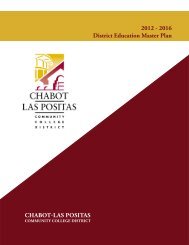City College of San Francisco - California Competes
City College of San Francisco - California Competes
City College of San Francisco - California Competes
You also want an ePaper? Increase the reach of your titles
YUMPU automatically turns print PDFs into web optimized ePapers that Google loves.
THEME II<br />
While indirect measures can provide useful information about the effectiveness <strong>of</strong> services, they are also<br />
fraught with challenges that need to be addressed. For example, “a decrease in the number <strong>of</strong> students<br />
being denied graduation due to incomplete coursework” may not be a direct result <strong>of</strong> students “reading<br />
and comprehending the CCSF graduation requirements and utilizing the [soon-to-be-operational] Degree<br />
Audit [program].” It might be the result <strong>of</strong> more effective use <strong>of</strong> the degree audit program by counselors<br />
and other staff or some other intervention provided by an <strong>of</strong>fice other than Admissions and Records.<br />
Similarly, DSPS faces significant challenges in developing and assessing students’ self-advocacy. If counselors<br />
and staff develop strategies to promote more timely requests for accommodations (e.g., better<br />
publicity <strong>of</strong> deadlines, direct requests to students, etc.), does this undermine the students’ development<br />
<strong>of</strong> independence and self-advocacy While this question is a classic example <strong>of</strong> one <strong>of</strong> the underlying<br />
struggles that DSPS pr<strong>of</strong>essionals grapple with in the design and implementation <strong>of</strong> student development<br />
programs, it is also a significant question to be addressed by these pr<strong>of</strong>essionals as they attempt to assess<br />
the effectiveness <strong>of</strong> their programs and services.<br />
Clearly, direct measures <strong>of</strong> student learning are the most effective means for assessing the effectiveness<br />
<strong>of</strong> programs and services in developing SLOs. Several <strong>of</strong> the departments in Student Development have<br />
programs that are consistent with traditional learning assessment tools used in other instructional departments<br />
(e.g., tests, essays, etc.). For example, the Learning Assistance Department, the Career Development<br />
and Placement Center, and DSPS <strong>of</strong>fer courses and workshops that can use testing and other traditional<br />
assessment tools to determine the extent to which these <strong>of</strong>ferings are producing specific student outcomes.<br />
A few departments propose tracking specific student behaviors that are directly related to the desired<br />
developmental outcomes as a means for directly assessing program effectiveness. For example, Student<br />
Health Services suggests a review <strong>of</strong> students’ medical history documents to determine the extent to which<br />
students followed medical advice or implemented suggested healthy activities.<br />
Continuing Student Counseling proposes the use <strong>of</strong> a classic “input-treatment-outcomes” model for assessing<br />
some <strong>of</strong> its SLOs. They suggest that a random sample <strong>of</strong> students could be surveyed at the time they<br />
become eligible for CSCD services, i.e., completed one year <strong>of</strong> college or more than 24 units <strong>of</strong> college<br />
credit. Then students could be surveyed again at the time they are leaving the institution. These surveys<br />
could include information about shifts in students’ attitudes such as academic confidence, goals, and<br />
achievements, as well as information about the amount and type <strong>of</strong> services that students used during<br />
their time within the CSCD’s period <strong>of</strong> responsibility for advising the student. This “input-output” data<br />
might produce a useful assessment <strong>of</strong> the “value added” by Continuing Counseling. However, the CSCD’s<br />
response to the initial inventory questionnaire contains significant cautionary notes about the validity<br />
<strong>of</strong> this type <strong>of</strong> assessment. Since students served by Continuing Student Counseling have already been<br />
affected by other student development programs and services, it is difficult to distinguish between the<br />
direct impact <strong>of</strong> CSCD and the delayed effect <strong>of</strong> other services. In addition, factors such as age and maturity<br />
must be considered. Therefore, the assessments <strong>of</strong> these outcomes will require fairly sophisticated<br />
research and analyses.<br />
Such cautionary statements reflect a Division that is not only aware <strong>of</strong> the need to develop direct measures<br />
<strong>of</strong> effectiveness, but is also sensitive to the research complexities <strong>of</strong> confounding variables. This is the type<br />
<strong>of</strong> thinking, planning, and development that the new accreditation standards seek to encourage. By directly<br />
confronting the challenges <strong>of</strong> assessing student learning outcomes in student development the Division<br />
is operationalizing its mission statement and defining its programs in terms <strong>of</strong> effectiveness. As the process<br />
continues it will also reap the benefits <strong>of</strong> these assessments.<br />
274 CITY COLLEGE OF SAN FRANCISCO







